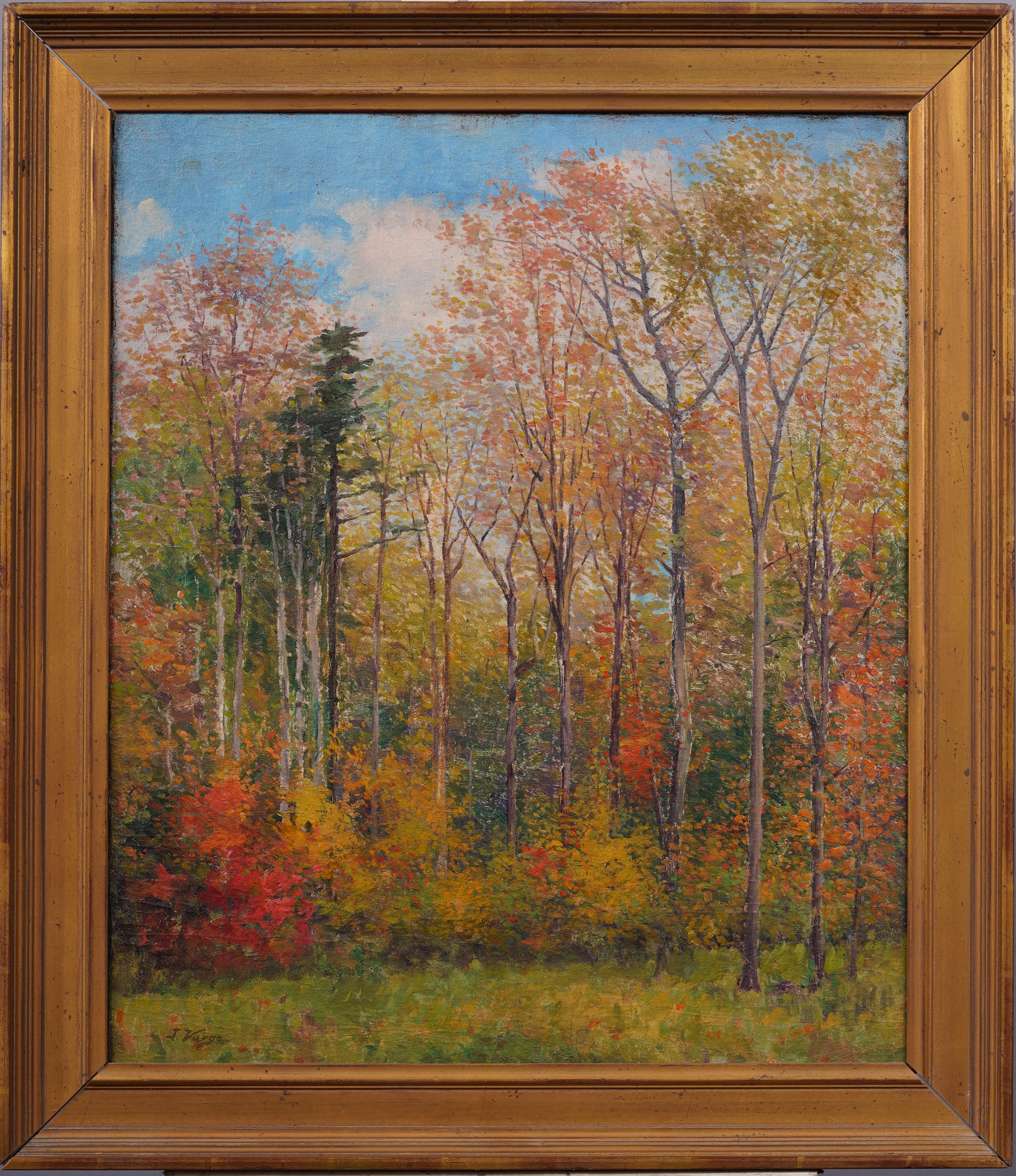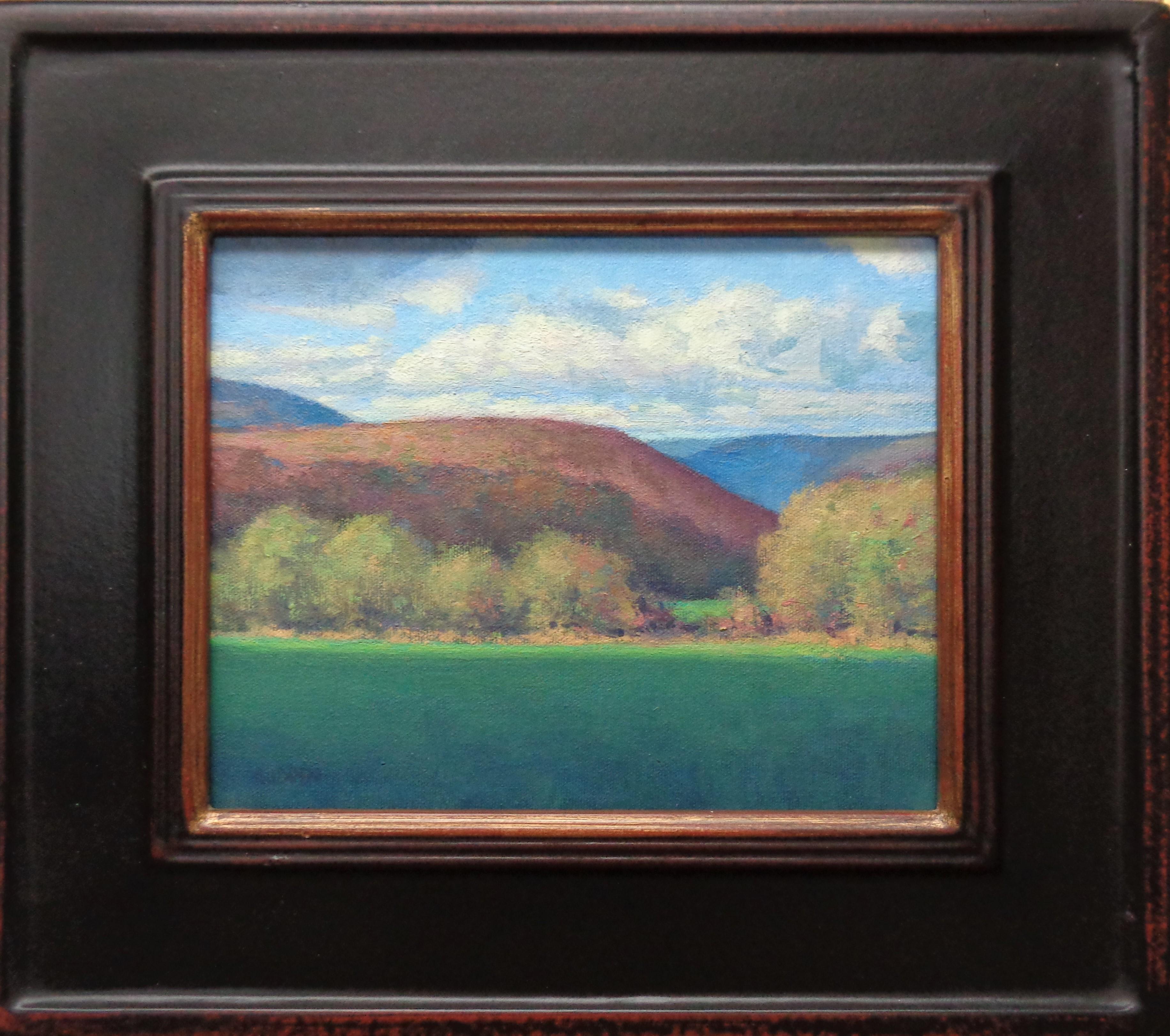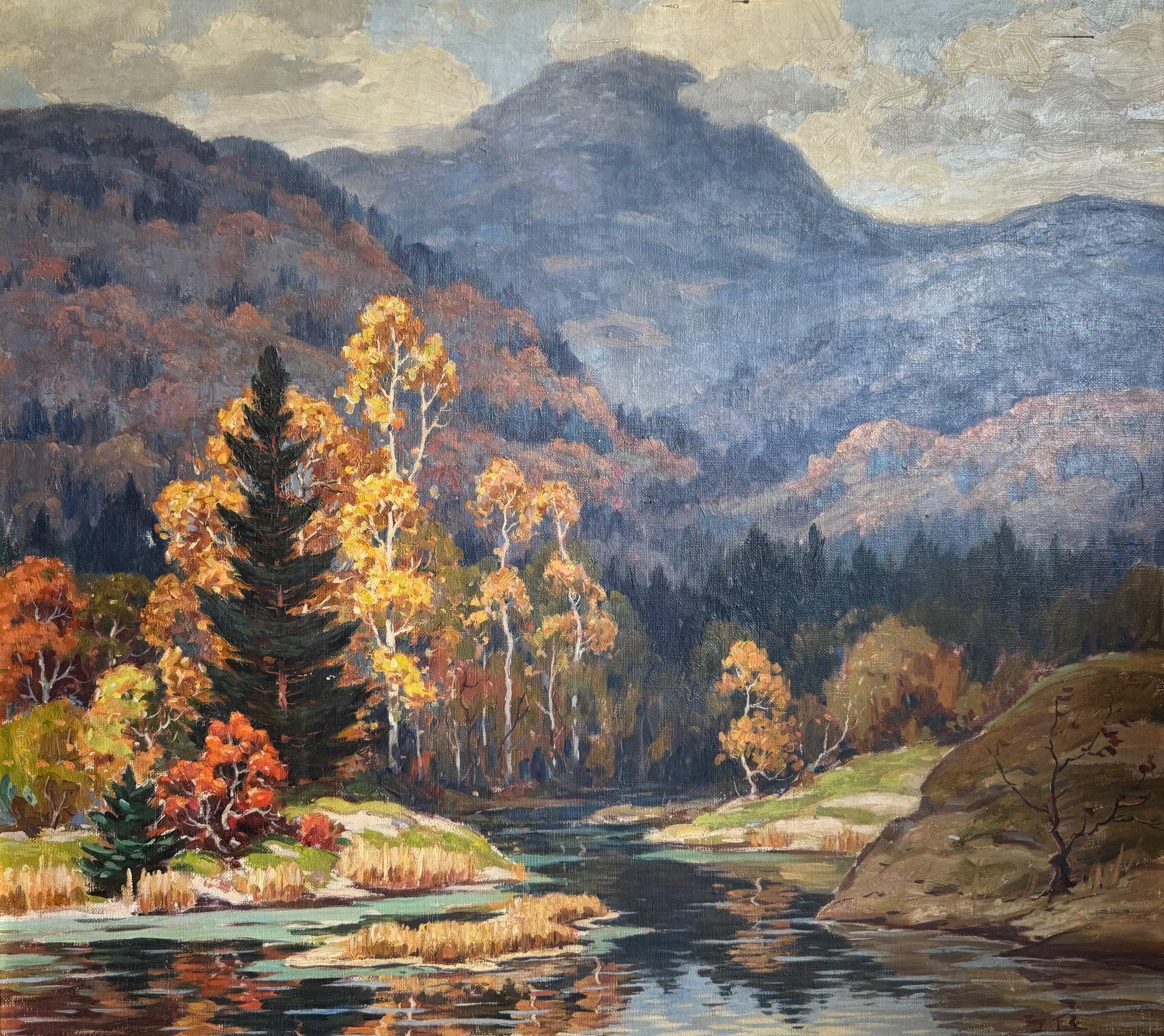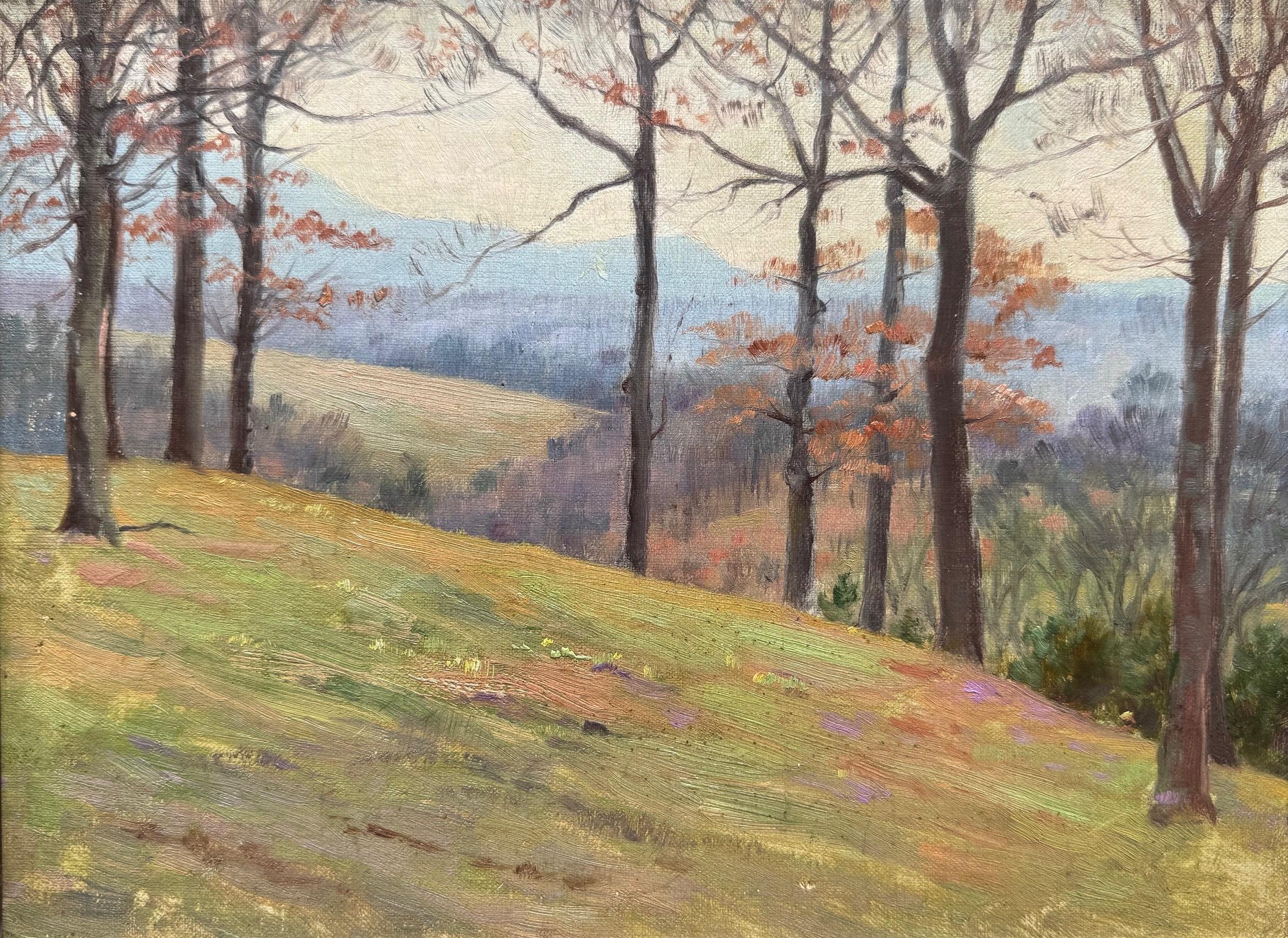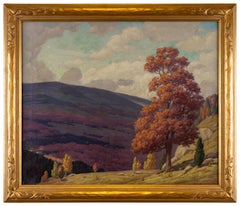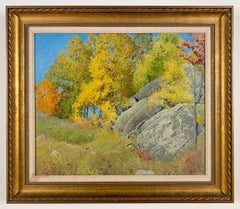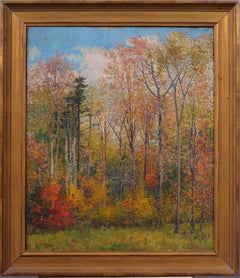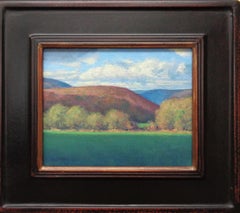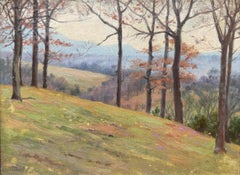Items Similar to Blue Ridge Mountains, Virginia
Want more images or videos?
Request additional images or videos from the seller
1 of 8
Andrew Thomas SchwartzBlue Ridge Mountains, Virginia
$5,800
£4,382.87
€5,061.14
CA$8,104.62
A$8,992.76
CHF 4,710.60
MX$110,275.42
NOK 59,917.25
SEK 56,559.33
DKK 37,744.08
Shipping
Retrieving quote...The 1stDibs Promise:
Authenticity Guarantee,
Money-Back Guarantee,
24-Hour Cancellation
About the Item
Andrew Thomas Schwartz
American, 1867-1942
Blue Ridge Mountains, Virginia
Oil on canvas
24 by 30 in. W/frame 28 ½ by 34 ½ in.
Signed lower right
Andrew T. Schwartz was born in Louisville, Kentucky. His early education was in the public schools of his hometown, where he showed great promise as an artist. In 1890, he began intense art study with the famed Frank Duveneck at the Cincinnati ArtAcademy. He later studied with H. Siddons Mowbray at the Art Students League in New York, where he was awarded the Lazarus Scholarship for mural painting to study abroad, which resulted in three years of study in Italy, France, Germany and England. He was, at the time, only the second person to win that award. His work from the Lazarus trip was the subject of an individual show at the Pratt Institute in Brooklyn.
He returned to the United States to assist his teacher Mowbray in decorating the University Club and J. P. Morgan’s private library in New York. He later worked independently and developed a following as a mural painter. His reputation was certainly enhanced by the mural Christ, the Good Shepherd for the Baptist Church in South Londonderry, Vermont, which was considered at the time one of the best examples of mural painting. Other murals were painted for the Courthouse of New York, the New York YMCA, the Atkins Museum of Fine Art in Kansas City and the Kansas City Life Insurance Company Building.
Schwartz also painted a number of other paintings in addition to his murals, including both figurative and landscapes. Many of his landscapes are views of New England. He exhibited extensively at the National Academy of Design, Pennsylvania Academy of the Fine Arts in Philadelphia, the Art Institute of Chicago, the Carnegie Institute in Pittsburgh, and other major cities.
He was a member of the National Society of Mural Painters, the Salmagundi Club, the Architectural League of New York, Allied Artists of America, American Watercolor Society, the Circolo Artistico of Rome, Italy, and the Union International Des Beaux Arts et Des Lettres of Paris, France.
A memorial show of Schwartz’s work was held at the Lotus Club of New York City in 1944 through the efforts of the sculptor, Charles Keck. The dean of art critics of the time, Royal Cortissoz, viewed Schwartz’s work before the exhibition in Keck’s studio and wrote, "Schwartz could saturate an Italian scene in the handsome ‘Roman Twilight’ but when he came to paint the countryside of his native land he was moved solely by its racy sentiment. He had charm as well as craftsmanship."
Provenance:
Private Collection, New York
Le Trianon Fine Art & Antiques
Art S111
- Creator:Andrew Thomas Schwartz (1867 - 1942, American)
- Dimensions:Height: 28.5 in (72.39 cm)Width: 34.5 in (87.63 cm)Depth: 2 in (5.08 cm)
- Medium:
- Movement & Style:
- Period:
- Condition:
- Gallery Location:Sheffield, MA
- Reference Number:Seller: Art S1111stDibs: LU70036201362
About the Seller
4.0
Vetted Professional Seller
Every seller passes strict standards for authenticity and reliability
1stDibs seller since 2017
55 sales on 1stDibs
Typical response time: 9 hours
- ShippingRetrieving quote...Shipping from: Sheffield, MA
- Return Policy
Authenticity Guarantee
In the unlikely event there’s an issue with an item’s authenticity, contact us within 1 year for a full refund. DetailsMoney-Back Guarantee
If your item is not as described, is damaged in transit, or does not arrive, contact us within 7 days for a full refund. Details24-Hour Cancellation
You have a 24-hour grace period in which to reconsider your purchase, with no questions asked.Vetted Professional Sellers
Our world-class sellers must adhere to strict standards for service and quality, maintaining the integrity of our listings.Price-Match Guarantee
If you find that a seller listed the same item for a lower price elsewhere, we’ll match it.Trusted Global Delivery
Our best-in-class carrier network provides specialized shipping options worldwide, including custom delivery.More From This Seller
View AllBlue Ridge Mountains, Virginia
By Andrew Thomas Schwartz
Located in Sheffield, MA
Andrew Thomas Schwartz
American, 1867-1942
Blue Ridge Mountains, Virginia
Oil on canvas
24 by 30 in, w/ frame 28 ½ by 34 ½ in
Signed lower right
Andrew T. Schwartz was born in Loui...
Category
Early 20th Century Impressionist Landscape Paintings
Materials
Oil
The Valley, York Maine
Located in Sheffield, MA
Alice R. Comins
American, 1861-1943
The Valley, York Maine
Oil on canvas
20 by 26 in. W/frame 27 by 33 in.
Signed lower right and dated 1913 & titled on r...
Category
1910s American Impressionist Landscape Paintings
Materials
Oil
Mountainous Landscape
By Jacques Martin-Ferrières
Located in Sheffield, MA
Jacques Martin-Ferrieres
French, 1893 – 1972
Mountainous Landscape
Oil on canvas
25 ½ by 32 in, w/ frame 34 by 40 ¼ in
Signed lower right “Martin Ferrieres”
A painter remarkable ...
Category
Early 20th Century Post-Impressionist Landscape Paintings
Materials
Oil
Sunny Hedge
By Frank Vincent Dumond
Located in Sheffield, MA
Frank Vincent Dumond
American, 1865-1931
Sunny Hedge
Oil on canvas
Signed "F.V. DuMond," lower right
24.5 in. by 29 in. W/frame 32.5 by 37 in.
Born in Rochester, New York in 1865, Frank DuMond left his work as an illustrator at age 23 to study in the rigorous classical atelier tradition of the Academie Julian Paris in 1888. Upon his return to New York in 1892, DuMond embarked on a painting and teaching term at the Art Students League spanning nearly six decades until his death.
A painter of diverse talents, he was an accomplished landscape, portrait and still life painter, muralist, and leader of the Tonalist then Impressionist art colonies of Lyme, Connecticut. In particular, DuMond was noted for his use of landscape green. American Impressionist expert William H. Gerdts wrote of DuMond, "As one might speak of Velazquez's blacks, one must speak of DuMond's greens." Scholars have described him as a deft painter of the American Impressionist landscape and the figure, but he will perhaps be remembered as among the most outstanding educators in American art history. Though an accomplished painter, he is said to have considered himself more of an educator than an artist.
By all accounts, DuMond is described by his students as a man whose art and teaching methods were based on deeply held religious and philosophical beliefs. One student recalls, "There were occasions when DuMond revealed a clear intent to educate us on a deeper level than might casually be associated with painting." His students remember him fondly as "a genial, generous, and perceptive instructor…whose warmth and kindness pervaded everything he did." Under his tutelage, many prominent American artists were brought to recognition, including Georgia O'Keeffe, Norman Rockwell, and John Marin. Still other protégés of DuMond renown became influential teachers, such as Baroque-style painter Frank Mason, whose influence emerged in New York at the Art Students League; and Arthur Maynard...
Category
1920s Post-Impressionist Landscape Paintings
Materials
Oil
Stony Brook, Long Island
By Paul Bernard King
Located in Sheffield, MA
Paul Bernard King
American, 1867-1947
Stony Brook, Long Island
Oil on canvas
25 ¼ by 30 ¼ in, w/ frame 34 ¼ by 39 ¼ in
Signed and titled verso
Traditional American painter Paul Kin...
Category
Early 20th Century Impressionist Landscape Paintings
Materials
Oil
Spring Landscape
By George Laurence Nelson
Located in Sheffield, MA
George Laurence Nelson
American, 1887-1978
Spring Landscape
Oil on canvas
20 ⅛ by 24 ⅛ in, w/ frame 28 by 32 in
Signed and dated 1912 lower right
George Laurence Nelson was born in...
Category
1910s Impressionist Landscape Paintings
Materials
Oil
You May Also Like
Antique American Impressionist Upstate New York Regionalist Landscape Painting
Located in Buffalo, NY
Antique American impressionist landscape oil painting. Oil on canvas. Signed. Framed. Measuring 27 by 31 inches overall and 21.5 by 26 painting alone.
Category
1890s Impressionist Landscape Paintings
Materials
Canvas, Oil
Impressionistic Mountain Landscape Oil Painting Michael Budden Vermont Hills I
By Michael Budden
Located in Chesterfield, NJ
Vermont Hills 1
oil/panel
8n x 10 unframed 13.5 x 15.5 framed
Vermont Hills I is an oil painting on canvas panel that showcases the beautiful light shinning on a Vermont mountain sce...
Category
21st Century and Contemporary Impressionist Landscape Paintings
Materials
Oil
Mt. Greylock - Holder Wenzel Jensen
Located in North Clarendon, VT
Exhibited, well painted,fall impressionist scene of Mt Greylock, Massachusetts painted by Holger Wenzel Jensen. Exhibition label attached verso.
Exhibited, Chicago Galleries Associ...
Category
Early 1900s American Impressionist Landscape Paintings
Materials
Oil
Hillside in Vermont - American School
Located in North Clarendon, VT
Beautiful unsigned American School impressionist oil on board of a hillside during the fall in Vermont. We'll painted by an obviously talented artist and housed in a period arts and ...
Category
1910s American Impressionist Landscape Paintings
Materials
Oil
Gloucester Artist Emile A. Gruppe Autumn Landscape Painting
Located in Rockport, MA
This radiant landscape by Emile A. Gruppe captures the warm, rolling hills of a peak autumn. Gruppe’s expressive impasto and dynamic color handling bring the countryside to life, evo...
Category
20th Century American Impressionist Landscape Paintings
Materials
Oil
Rocky Mountain Vista
By John Terelak
Located in Wiscasett, ME
A monumental 59" x 82" with frame oil on canvas painting of a rocky mountain vista by John Terelak. Signed and dated lower left and inscribed verso. It...
Category
1990s American Impressionist Landscape Paintings
Materials
Oil
More Ways To Browse
The Good Shepherd
J W Thomas
German Shepherd Antique
Andrew Carnegie
Antique Vermont
German Shepherd Painting
Blue Ridge Mountains Oil Painting
Paddle Boat
Sterling Travel Frame
Susan Hiller
Taos Pueblo
William Hollingsworth
1985 Christian Dior
Arc De Triomphe Painting
Edward P Paul And Company Co
Etienne Robert
French Basque Country
Hughes E J

